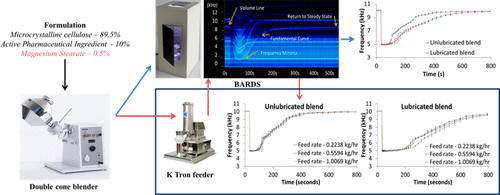当前位置:
X-MOL 学术
›
Mol. Pharmaceutics
›
论文详情
Our official English website, www.x-mol.net, welcomes your
feedback! (Note: you will need to create a separate account there.)
Broadband Acoustic Resonance Dissolution Spectroscopy (BARDS): A Novel Approach To Investigate the Wettability of Pharmaceutical Powder Blends
Molecular Pharmaceutics ( IF 4.5 ) Pub Date : 2017-11-29 00:00:00 , DOI: 10.1021/acs.molpharmaceut.7b00658 Raghu V. G. Peddapatla 1 , M. Rizwan Ahmed 2 , Caroline A. Blackshields 1 , M. J. Sousa-Gallagher 3 , Sean McSweeney 2 , J. Kruse 4 , Abina M. Crean 1, 5 , Dara Fitzpatrick 2
Molecular Pharmaceutics ( IF 4.5 ) Pub Date : 2017-11-29 00:00:00 , DOI: 10.1021/acs.molpharmaceut.7b00658 Raghu V. G. Peddapatla 1 , M. Rizwan Ahmed 2 , Caroline A. Blackshields 1 , M. J. Sousa-Gallagher 3 , Sean McSweeney 2 , J. Kruse 4 , Abina M. Crean 1, 5 , Dara Fitzpatrick 2
Affiliation

|
The ability of broadband acoustic resonance dissolution spectroscopy (BARDS) to assess the wettability of powder blends is investigated. BARDS is a novel analytical technology developed on the basis of the change in acoustic phenomena observed when material is added into a solvent under resonance. Addition of solid material to the solvent results in the introduction of gas (air) into the solvent, changing the compressibility of the solvent system, and reducing the velocity of sound in the solvent. As a material is wetted and dissolved, the gas is released from the solvent and resonance frequency is altered. The main purpose of this work is to demonstrate the ability of BARDS to assess differences in the wetting behavior of tablet excipients (microcrystalline cellulose (MCC) and magnesium stearate (MgSt)) and a model drug (metoclopramide hydrochloride) as single component powders and multicomponent powder blends. BARDS acoustic responses showed a prolonged release of gas for the powdered blends with lubricant compared to unlubricated blends. As the elimination of gas from the solvent was assumed to follow first order elimination kinetics, a compressible gas elimination rate constant was calculated from the log plots of the gas volume profiles. The gas elimination rate constant was used as a parameter to compare the release of gas from the powder introduced to the solvent and hence the powder wetting behavior. A lower gas elimination rate constant was measured for lubricated blends compared to nonlubricated blends, suggesting the prolonged hydration of lubricated blends. Standard wetting techniques such as contact angle measurements and wetting time analysis were also used to analyze the blends and confirmed differences in wetting behavior determined by BARDS. The study results demonstrate the capability of BARDS as a rapid, analytical tool to determine the wetting behavior of the pharmaceutical powder blends and the potential of BARDS as a process analytical technology (PAT) tool.
中文翻译:

宽带声共振溶解光谱法(BARDS):研究药物粉末混合物可湿性的新方法
研究了宽带声共振溶解光谱法(BARDS)评估粉末混合物的润湿性的能力。BARDS是一种新的分析技术,其开发是基于在共振条件下将材料添加到溶剂中时观察到的声学现象的变化。将固体材料添加到溶剂中会导致将气体(空气)引入溶剂中,从而改变溶剂系统的可压缩性,并降低溶剂中的声速。随着材料的润湿和溶解,气体会从溶剂中释放出来,共振频率也会改变。这项工作的主要目的是证明BARDS能够评估片剂赋形剂(微晶纤维素(MCC)和硬脂酸镁(MgSt))和模型药物(甲氧氯普洛胺)作为单组分粉末和多组分的润湿行为的差异。粉末混合物。与未润滑的混合物相比,BARDS的声学响应表明,与润滑剂混合的粉末混合物的气体释放时间延长。由于假定从溶剂中去除气体遵循一级去除动力学,因此可根据气体体积曲线的对数图计算出可压缩的气体去除速率常数。将气体消除速率常数用作参数,以比较引入到溶剂中的粉末中的气体释放量以及粉末的湿润行为。与未润滑的混合物相比,测得的润滑混合物的气体消除速率常数较低,表明润滑的混合物的水合时间延长。还使用标准的润湿技术(例如接触角测量和润湿时间分析)来分析共混物,并确定由BARDS确定的润湿行为差异。研究结果证明了BARDS作为确定药物粉末混合物润湿行为的快速分析工具的能力,以及BARDS作为过程分析技术(PAT)工具的潜力。还使用标准的润湿技术(例如接触角测量和润湿时间分析)来分析共混物,并确定由BARDS确定的润湿行为差异。研究结果证明了BARDS作为确定药物粉末混合物润湿行为的快速分析工具的能力,以及BARDS作为过程分析技术(PAT)工具的潜力。还使用标准的润湿技术(例如接触角测量和润湿时间分析)来分析共混物,并确定由BARDS确定的润湿行为差异。研究结果证明了BARDS作为确定药物粉末混合物润湿行为的快速分析工具的能力,以及BARDS作为过程分析技术(PAT)工具的潜力。
更新日期:2017-11-29
中文翻译:

宽带声共振溶解光谱法(BARDS):研究药物粉末混合物可湿性的新方法
研究了宽带声共振溶解光谱法(BARDS)评估粉末混合物的润湿性的能力。BARDS是一种新的分析技术,其开发是基于在共振条件下将材料添加到溶剂中时观察到的声学现象的变化。将固体材料添加到溶剂中会导致将气体(空气)引入溶剂中,从而改变溶剂系统的可压缩性,并降低溶剂中的声速。随着材料的润湿和溶解,气体会从溶剂中释放出来,共振频率也会改变。这项工作的主要目的是证明BARDS能够评估片剂赋形剂(微晶纤维素(MCC)和硬脂酸镁(MgSt))和模型药物(甲氧氯普洛胺)作为单组分粉末和多组分的润湿行为的差异。粉末混合物。与未润滑的混合物相比,BARDS的声学响应表明,与润滑剂混合的粉末混合物的气体释放时间延长。由于假定从溶剂中去除气体遵循一级去除动力学,因此可根据气体体积曲线的对数图计算出可压缩的气体去除速率常数。将气体消除速率常数用作参数,以比较引入到溶剂中的粉末中的气体释放量以及粉末的湿润行为。与未润滑的混合物相比,测得的润滑混合物的气体消除速率常数较低,表明润滑的混合物的水合时间延长。还使用标准的润湿技术(例如接触角测量和润湿时间分析)来分析共混物,并确定由BARDS确定的润湿行为差异。研究结果证明了BARDS作为确定药物粉末混合物润湿行为的快速分析工具的能力,以及BARDS作为过程分析技术(PAT)工具的潜力。还使用标准的润湿技术(例如接触角测量和润湿时间分析)来分析共混物,并确定由BARDS确定的润湿行为差异。研究结果证明了BARDS作为确定药物粉末混合物润湿行为的快速分析工具的能力,以及BARDS作为过程分析技术(PAT)工具的潜力。还使用标准的润湿技术(例如接触角测量和润湿时间分析)来分析共混物,并确定由BARDS确定的润湿行为差异。研究结果证明了BARDS作为确定药物粉末混合物润湿行为的快速分析工具的能力,以及BARDS作为过程分析技术(PAT)工具的潜力。











































 京公网安备 11010802027423号
京公网安备 11010802027423号